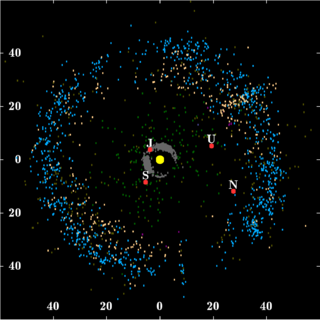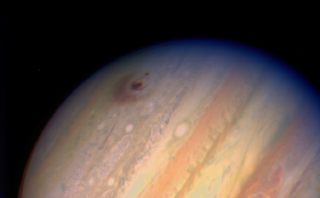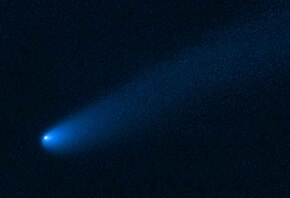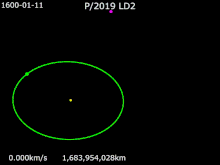
A comet is an icy, small Solar System body that warms and begins to release gases when passing close to the Sun, a process called outgassing. This produces an extended, gravitationally unbound atmosphere or coma surrounding the nucleus, and sometimes a tail of gas and dust gas blown out from the coma. These phenomena are due to the effects of solar radiation and the outstreaming solar wind plasma acting upon the nucleus of the comet. Comet nuclei range from a few hundred meters to tens of kilometers across and are composed of loose collections of ice, dust, and small rocky particles. The coma may be up to 15 times Earth's diameter, while the tail may stretch beyond one astronomical unit. If sufficiently close and bright, a comet may be seen from Earth without the aid of a telescope and can subtend an arc of up to 30° across the sky. Comets have been observed and recorded since ancient times by many cultures and religions.

2060 Chiron is a small Solar System body in the outer Solar System, orbiting the Sun between Saturn and Uranus. Discovered in 1977 by Charles Kowal, it was the first-identified member of a new class of objects now known as centaurs—bodies orbiting between the asteroid belt and the Kuiper belt. Chiron is named after the centaur Chiron in Greek mythology.

In planetary astronomy, a centaur is a small Solar System body that orbits the Sun between Jupiter and Neptune and crosses the orbits of one or more of the giant planets. Centaurs generally have unstable orbits because they cross or have crossed the orbits of the giant planets; almost all their orbits have dynamic lifetimes of only a few million years, but there is one known centaur, 514107 Kaʻepaokaʻawela, which may be in a stable orbit. Centaurs typically exhibit the characteristics of both asteroids and comets. They are named after the mythological centaurs that were a mixture of horse and human. Observational bias toward large objects makes determination of the total centaur population difficult. Estimates for the number of centaurs in the Solar System more than 1 km in diameter range from as low as 44,000 to more than 10,000,000.

944 Hidalgo is a centaur and unusual object on an eccentric, cometary-like orbit between the asteroid belt and the outer Solar System, approximately 52 kilometers in diameter. Discovered by German astronomer Walter Baade in 1920, it is the first member of the dynamical class of centaurs ever to be discovered. The dark D-type object has a rotation period of 10.1 hours and likely an elongated shape. It was named after Mexican revolutionary Miguel Hidalgo y Costilla.

The Panoramic Survey Telescope and Rapid Response System located at Haleakala Observatory, Hawaii, US, consists of astronomical cameras, telescopes and a computing facility that is surveying the sky for moving or variable objects on a continual basis, and also producing accurate astrometry and photometry of already-detected objects. In January 2019 the second Pan-STARRS data release was announced. At 1.6 petabytes, it is the largest volume of astronomical data ever released.
Mount Lemmon Survey (MLS) is a part of the Catalina Sky Survey with observatory code G96. MLS uses a 1.52 m (60 in) cassegrain reflector telescope operated by the Steward Observatory at Mount Lemmon Observatory, which is located at 2,791 meters (9,157 ft) in the Santa Catalina Mountains northeast of Tucson, Arizona.
60558 Echeclus is a centaur, approximately 84 kilometers (52 miles) in diameter, located in the outer Solar System. It was discovered by Spacewatch in 2000 and initially classified as a minor planet with provisional designation 2000 EC98 (also written 2000 EC98). Research in 2001 by Rousselot and Petit at the Besançon observatory in France indicated that it was not a comet, but in December 2005 a cometary coma was detected. In early 2006 the Committee on Small Bodies Nomenclature (CSBN) gave it the cometary designation 174P/Echeclus. It last came to perihelion in April 2015, and was expected to reach about apparent magnitude 16.7 near opposition in September 2015.

9912 Donizetti, provisional designation 2078 T-3, is a stony Rafita asteroid from the central regions of the asteroid belt, approximately 7 km in diameter. It was discovered during the third Palomar–Leiden Trojan survey in 1977, and named after Italian composer Gaetano Donizetti.
83982 Crantor (provisional designation 2002 GO9) is a centaur in a 1:1 resonance with Uranus, approximately 60 kilometers (37 miles) in diameter. It was discovered on 12 April 2002, by astronomers of the Near-Earth Asteroid Tracking at the Palomar Observatory in California, United States. This minor planet was named for Crantor from Greek mythology.
4827 Dares is a larger Jupiter trojan from the Trojan camp, approximately 43 kilometers in diameter. It was discovered on 17 August 1988 by American astronomer Carolyn Shoemaker at the Palomar Observatory in California. The dark D-type asteroid has a rotation period of 19.0 hours. It was named after Dares from Greek mythology.
4007 Euryalos is a larger Jupiter trojan from the Greek camp, approximately 48 kilometers in diameter. It was discovered on 19 September 1973, by Dutch astronomers Ingrid and Cornelis van Houten at Leiden, and Tom Gehrels at Palomar Observatory in California. The likely spherical Jovian asteroid is the principal body of the proposed Euryalos family and has a rotation period of 6.4 hours. It was named after the warrior Euryalus from Greek mythology.
20898 Fountainhills (provisional designation 2000 WE147) is a dark asteroid in a cometary orbit (ACO) from the outermost regions of the asteroid belt, approximately 37 kilometers (23 miles) in diameter. It was discovered on 30 November 2000, by American amateur astronomer Charles W. Juels at the Fountain Hills Observatory in Arizona, United States. The D-type asteroid has a rotation period of 12.84 hours. It was named for the city of Fountain Hills, Arizona, in the United States.
5028 Halaesus is a Jupiter trojan from the Greek camp, approximately 51 kilometers in diameter. It was discovered on 23 January 1988 by American astronomer Carolyn Shoemaker at the Palomar Observatory in California. The dark D-type asteroid has a rotation period of 24.9 hours and belongs to the 100 largest Jupiter trojans. It was named after Halaesus from Greek mythology.
4138 Kalchas is a large Jupiter trojan from the Greek camp, approximately 53 kilometers in diameter. It was discovered on 19 September 1973, by Dutch astronomers Ingrid and Cornelis van Houten at Leiden, on photographic plates taken by Tom Gehrels at the Palomar Observatory in California. The assumed C-type asteroid is the principal body of the proposed Kalchas family and has a rotation period of 29.2 hours. It was named after the seer Calchas from Greek mythology.

An extinct comet is a comet that has expelled most of its volatile ice and has little left to form a tail and coma. In a dormant comet, rather than being depleted, any remaining volatile components have been sealed beneath an inactive surface layer.
(457175) 2008 GO98 (provisional designation 2008 GO98) with cometary number 362P, is a Jupiter family comet in a quasi-Hilda orbit within the outermost regions of the asteroid belt. It was discovered on 8 April 2008, by astronomers of the Spacewatch program at Kitt Peak National Observatory near Tucson, Arizona, in the United States. This presumably carbonaceous body has a diameter of approximately 15 kilometers (9 miles) and rotation period of 10.7 hours.
12929 Periboea, provisional designation: 1999 TZ1, is a dark Jupiter trojan from the Trojan camp, approximately 54 kilometers (34 miles) in diameter. It was discovered on 2 October 1999, by American astronomer Charles W. Juels at the Fountain Hills Observatory in Arizona. Originally considered a centaur, this now re-classified Jovian asteroid has a rotation period of 9.3 hours and belongs to the 80 largest Jupiter trojans. It was named from Greek mythology after Periboea, mother of Pelagon by the river-god Axius.
(342842) 2008 YB3, provisional designation: 2008 YB3, is a sizable centaur and retrograde damocloid from the outer Solar System, approximately 67 kilometers (42 miles) in diameter. It was discovered on 18 December 2008, by astronomers with the Siding Spring Survey at the Siding Spring Observatory in Australia. The minor planet was numbered in 2012 and has since not been named.
(523676) 2013 UL10 (prov. designation:2013 UL10) is a reddish centaur with cometary activity orbiting the Sun between Jupiter and Uranus. It was discovered on 18 August 2010, by a team of astronomers with the Pan-STARRS survey at the Haleakalā Observatory, Hawaii. It is the first centaur known to have both comet-like activity and red surface colors. It is also one of the smallest centaurs, with a nucleus of no more than 10 kilometers (6.2 miles) in diameter. As of 2021, it has not been named.

In modern times, numerous impact events on Jupiter have been observed, the most significant of which was the collision of Comet Shoemaker–Levy 9 in 1994. Jupiter is the most massive planet in the Solar System and thus has a vast sphere of gravitational influence, the region of space where an asteroid capture can take place under favorable conditions.










